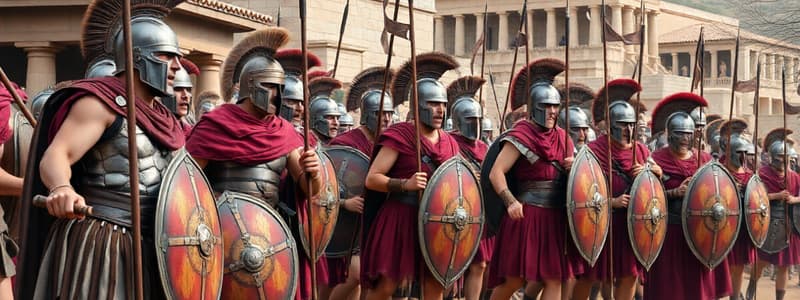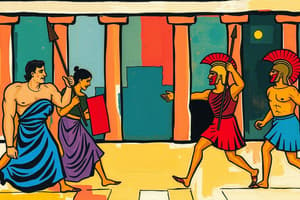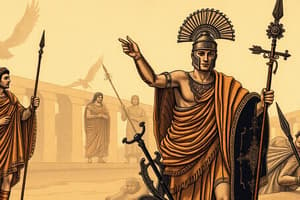Podcast
Questions and Answers
What was a key feature of Spartan society?
What was a key feature of Spartan society?
- Democratic governance
- Focus on artistic expression
- Economic equality
- Emphasis on military training (correct)
Helots were considered citizens of Sparta with full rights.
Helots were considered citizens of Sparta with full rights.
False (B)
What were Spartan young girls trained to do?
What were Spartan young girls trained to do?
Fight and become soldiers
Spartan citizens were supported by the work of the ______.
Spartan citizens were supported by the work of the ______.
Match the following groups with their descriptions:
Match the following groups with their descriptions:
Flashcards
Perioeci
Perioeci
Citizens of Sparta who were not full citizens, but had some rights and responsibilities. They paid taxes, served in the army and were protected by Spartan laws.
Helots
Helots
People from lands conquered and ruled by Sparta who had no rights and were treated like slaves. They had to farm the land and give half their crops to their Spartan masters.
Spartan Military Training
Spartan Military Training
A key aspect of Spartan society was its focus on military training. This involved rigorous physical and mental exercises, beginning from a young age.
Spartan Craftsmanship
Spartan Craftsmanship
Signup and view all the flashcards
Spartan Economy
Spartan Economy
Signup and view all the flashcards
Study Notes
Spartan Society
- Sparta was a prominent city-state in Ancient Greece, characterized by a highly militaristic culture.
- Spartan life was rigidly structured, mirroring a military lifestyle.
- Spartan boys were removed from their families early to undergo military training.
- Spartan girls also received training to maintain physical fitness and were prepared to be strong.
- Spartan society was stratified – citizens were either Perioeci or Helots.
- Perioeci were citizens who paid taxes, served in the army and were protected by Spartan law.
- Helots were conquered people with no rights, who farmed land for Spartan citizens and had to give half their crops as tribute.
- Helots were treated as slaves.
Spartan Economy and Trade
- Sparta's wealth stemmed from trade in luxury goods like gold, silver, and other materials.
- Increased wealth led to production of exquisite craftsmanship and beautiful items, including ivory carvings, bronze work, and pottery.
- These goods were exported to other areas like Italy.
Studying That Suits You
Use AI to generate personalized quizzes and flashcards to suit your learning preferences.




